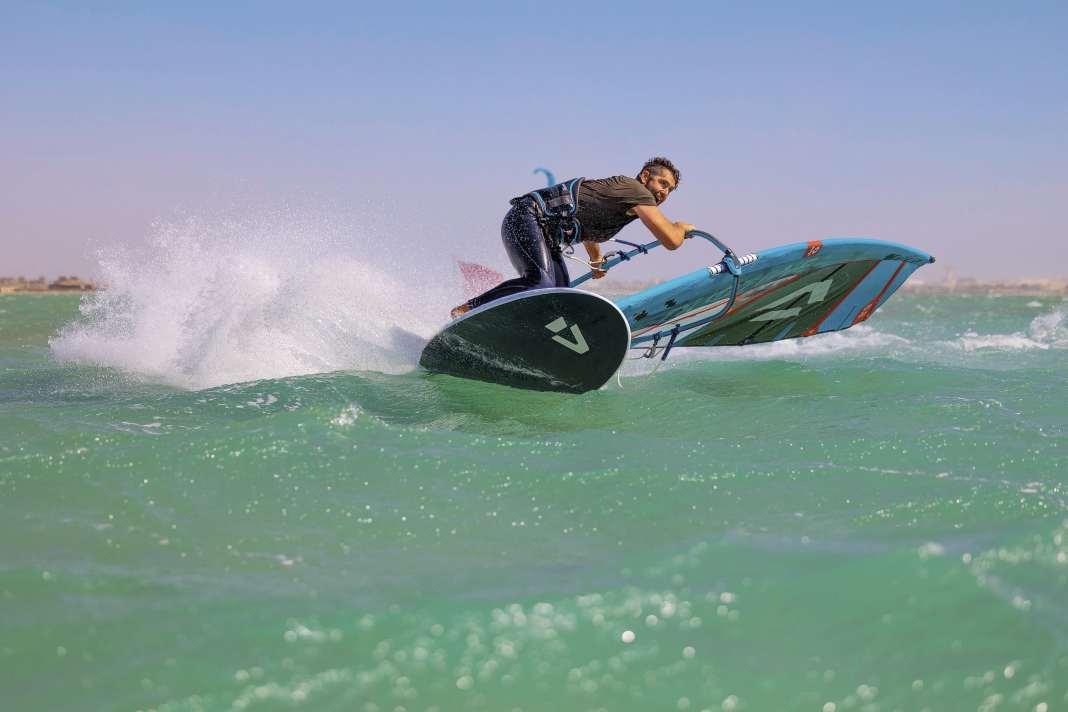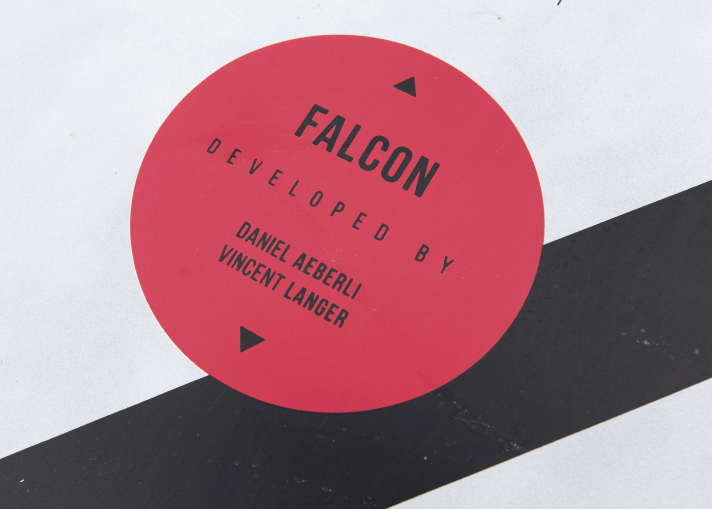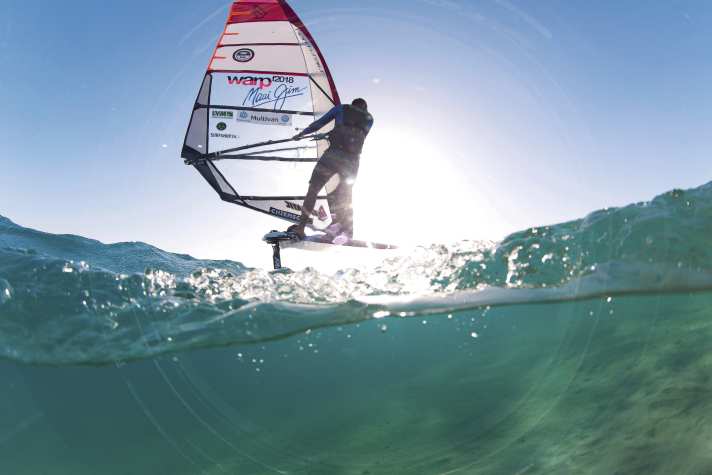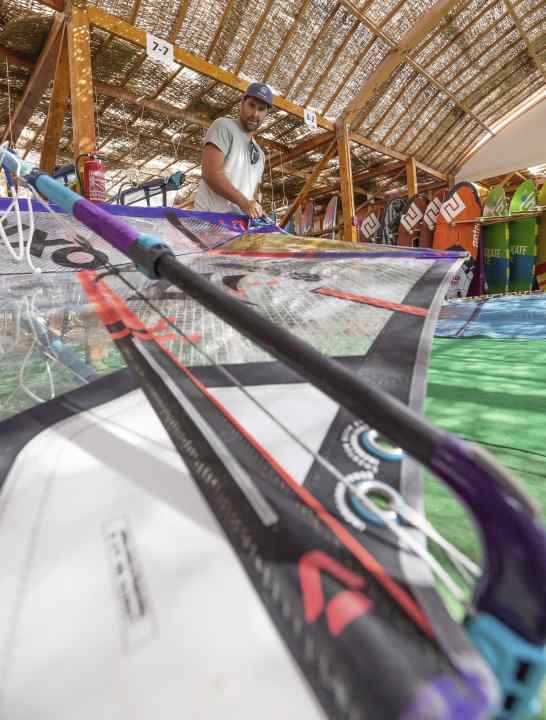





"The up-and-coming talent from Kiel" was the phrase repeatedly used in the press releases of the German Windsurf Cup around the 2010s when talking about Vincent Langer - even though he was already in his mid-20s at the time and had a failed Olympic campaign behind him. But by 2013 at the latest, the talented youngster had become the dominator in national windsurfing. According to his website, he won a total of 25 German championship titles, became European champion five times and world champion three times. Langer was and is particularly successful in slalom and formula racing. In addition to chasing his own titles, Vincent has now dedicated himself to promoting young talent with his Kids Camps.
I've had an unchanged contract with Duotone for eight years."
Last year, you said that you wanted to quit as a professional windsurfer to pursue a "normal" job. Then, a few months ago, you changed direction and continued as a windsurfer. It sounds perfectly understandable when you're 38 years old and now a father of two to turn your back on the water, doesn't it?
Yes, of course that sounds logical. I spoke and negotiated with my partner Duotone over the course of the season and I emphasised that I would get involved in something outside of the professional world. But the brand manager Raoul Joa and the product manager Daniel Aeberli were very motivated to continue working with me. I've had an unchanged contract with Duotone for eight years. This is probably unheard of in the entire industry, because in these times driver contracts are always revised downwards a good deal - due to the market situation.
In my case, I have a lot of fun in every single session on the water. My wife Jule flew home from Soma Bay yesterday with our two children and I wasn't able to take full advantage of the good wind phase with Peter Müller from the Surfmotion centre. The spot right in front of us is a top spot for windsurfing. Then Jule took off, there were only six knots and I went out on the water anyway! Why? I'm still really keen to train, work on my equipment and take part in regattas, and it's cool that some young, talented riders are coming along. But I still have so much fun windsurfing and probably more fun than these guys! Last year we had our second child and you have to realise that I'm responsible for the family, and as a professional surfer it's not easy.
You're one of the top 3 best-paid German windsurfing pros, aren't you?
If you take Philip Köster out of the equation, then I'm probably the best paid. But of course I can't do that without external partners such as VW Commercial Vehicles, Chiemsee, LVM, Surfshop24, Sea to Summit, Cellagon and other activities for a Hamburg-based company where I hold lectures and sports days on a wide variety of topics with former decathlete Frank Busemann and ex-ski jumper Martin Schmitt.
As you just said, your commitment has already changed over the last 20 years.
Yes, in the past I was keen to tear off 80 kilometres on the water here in Soma Bay and then train jibes on my bad side. I was focussed and wanted to achieve more performance, but I've come a long way from that. And it's a bit different now with a family. It used to be 10 to 14 events a year, but that's changed more into social media work - I reach around 300,000 people a month - as well as work for my partners in other directions.
In the past, your goal was to constantly improve your performance on the water and you contributed a lot to regatta windsurfing. Perhaps a little provocative, but without you, regatta windsurfing wouldn't be where it is today, would it?
I approached regatta surfing more professionally than almost all other riders. I thought about what I needed to be successful. For example, I didn't want to have the fastest board, but the board that could do the most. I wasn't the fastest in a straight line, but overall on the course I was. I influenced products a lot and, for example, we built a smaller, more agile board in 2016 - completely against the trend at the time - on which I became Formula World Champion in 2017.

Back then, your sail designer Kai Hopf never tired of emphasising that you don't need the fastest racing sail to win, but one that performs very well over the entire course, including after the gybes.
Yes, that fits in just as well. And I probably have a lot to say about Steve Allen (former slalom pro, the ed.) the greatest know-how about battening. I spend weeks making my own battens at home, sanding, drilling and laminating, which is incredibly useful to me because I now do less training, but I understand how sails work. No one else has this expertise in racing sails. And I've had a sailmaker's sewing machine at home for four years now, which I use to modify my sails the way I want them. As a rule, these changes are then incorporated into later series sails.
What changes could these be?
I needed a little more control with my 5.8 warp sail, so I put a little more tension on batten 1, i.e. the top batten. The top works a little less as a result, but pushes the nose of the board down a little. As a result, I make fewer mistakes and the first stroke from the start line to the first throat buoy is the most important. It does kill the acceleration a little, but I'm riding the 5.8 sail at around 35 knots, so that's not so important.
You have practised point starts (crossing the start line exactly at the starting shot) for months - perhaps like no other - throwing a buoy marker with a stone into the water and passing it with the timer on your upper arm at full speed at "zero".
Did I invent point starts? In any case, I practised point starts ad nauseam - whether in Heidkate or anywhere else. I definitely wanted to think out of the box and keep getting better. And that's definitely not top speed, because if you get off to a good start, you'll be in the top four at the first throat buoy. I always went to places where it was difficult to windsurf. For example, in Heidkate in front of the groynes, where the water sloshes back so nastily, I practised jibes. I never wanted to go in where it was slippery.
World Cup legend Antoine Albeau once said that when I'm at a World Cup, it "always sucks at the start and the tonnes". He appreciated where I start, where my strengths lie, and he enjoyed the fact that I was only at the World Cups a few times. In a way, he honoured the fact that I was so competitive. Furthermore, I always looked for people I could train well with and passed on my expertise to them without any ifs or buts.
I have also used a board or sail from another brand to achieve my goals."
"Without you, regatta windsurfing wouldn't be where it is today!" Is the claim true?
Bernd Flessner was one of the heroes back then, but didn't really pass on his knowledge. My Kids Camps have led to many former Kids Camp participants now competing in the DWC. And Michele (Michele Becker, slalom pro, the ed.) would not be where it is today without the camps. For me, it's important to be focussed, structured and to pass on material know-how. I would also appreciate more appreciation from Michele. I helped him get his first sponsor, lent him my racing masts and my top fins. I set up his equipment for him and this foundation probably doesn't exist anywhere else in the world. Now he hardly ever gets in touch.
You kept using your old boards and sails from the previous year and didn't go for the new model.
I'm probably the only one in the world. If the new equipment wasn't performing as well, I went to my sponsors, who then said: "Find a solution yourself." I then, yes, continued to use the old equipment or immediately used a board or sail from another brand to achieve my goals. It's not the case that racing equipment is always getting better. It doesn't always go forwards. You have to remember that we sail in different wind conditions in Germany than the World Cup riders on Gran Canaria or Fuerteventura and don't use an 8.4 at 30 knots in the Windsurf Cup.
Have there been any decisions that you would make differently today?
I always made the decisions that helped me move forward. It was all predictable. The foil was the biggest change in the sport in the last 20 years. And yes, there was better foil material than I got from my sponsor. I should have put more pressure on them, because we had material for a few years that wasn't the best.
Vincent, hand on heart - fin or foil?
For me, it's the fin! I like the "connection" to the water. The real windsurfing is with the fin. With the fin, I have to avoid the waves and it takes more fitness. Young regatta riders will never be as fast as Gunnar Asmussen, for example. Gunnar would still be faster even if he didn't sail with a fin for five years. That's simply down to experience.

What role models did you have in the past?
I had a poster of Bernd Flessner hanging in my room and my goal was to be as good as Bernd. I never wanted to become European champion or world champion, but German champion, like Flessi so often became.
You repeatedly said over a long period of time: "I came first behind Flessi."
It was the same for me for a while. It wasn't hostility, but motivation for more training, because Flessi was the king. In 2009, I beat Bernd for the first time on his home island of Norderney. But you first have to beat the fifth best, fourth best and so on. There are building blocks and steps that you crawl up. I sailed my first regatta when I was nine years old, then the first DWC in 2001 and so on. Back then there was Andy Laufer, Helge Wilkens and other good people. And today, the goal of other racers is "we have to beat the Langer", including Michele.
What are your strengths?
My great strength is to perform in difficult situations. To deliver my best performance on the last day. The last race is crucial and it's my mental strength. I'm the first one on the beach in the morning and I'd like to have ridden 20 kilometres before the first race. You don't win races through sheer speed, you have to be smart. So your head is by far the most decisive factor.
In which wind range are you strongest?
Good question, up to 20 knots. At over 20 knots, I was competitive on the Fin, but never world class. But that wasn't important to me either, because in Germany we usually race up to 20 knots.
What are your weaknesses?
As I said, I have deficits when there's a lot of wind. And I've sometimes worried too much about my equipment: I was at the regatta site a week before a DM and had seven form boards with me, which drove me crazy.
Have you realised your potential?
I couldn't have achieved more in anything than what I have achieved. I have made the most of my career. I wrote dozens of notebooks full of material know-how, which no one else in the world has. That is also an expression of meticulous preparation and a career mindset.

In 2016 and 2017, you were also one of the fastest internationally. Do you ever mourn the opportunity to have taken part in more World Cup races? According to your board and sailing sponsor, you were sure to receive support from them for more World Cup participations.
Missed opportunity? Yes, in terms of regatta results, I could have achieved more very good World Cup results. You have to recognise that. But that wasn't so important to me. I just wanted to have fun in Germany and not in Japan or anywhere else. I was sure to be recognised by the international riders. My former team-mate Pierre Mortefon also called me and asked me about our equipment and possible set-ups. I don't have to take part in Fuerteventura for that.
Keyword material. What has been your fastest set-up so far?
I can say that straight away! In 2016 it was the North Warp 8.4 with the Falcon 140L and 44 carpenter fin. Why do I still know that? I still have everything! They call me the "collector" in the team. I kept everything that went well. I could immediately ride with the form material with which I became world champion in 2016.
How many older sails do you have at your home in Kiel?
That's about 40 to 50 sails.
No!
Yes, for example my sail with which I won the DWC on Norderney for the first time. I've always sold mediocre sails. That's also a tic that I'll keep, and that's my history.
I've always kept my top sails, but I've always sold my mediocre sails."
To what extent were you superior with this 2016 material?
We got these very, very light boards from Cobra. In Kiel, I then had someone sand my 140 Falcon and paint it with a very rough nano coating. The board was very high in the water. The 8.4 Warp had a harder and extremely light mast pocket material. This set-up was the fastest compared to my competitors on the regatta courses. Or rather, I "flew" with it and it really "ignited" back then.
And this final question is a must. Philip Horn (Former top regatta surfer) once said that you really "set his son on fire" for windsurfing at your Kids Camp.
I was annoyed that we couldn't give any further support to young people who were too good for the windsurfing course. That was the origin of my Kids Camps. We had over 100 children take part last year and many of them will go on to take part in the DWCs! What I particularly like about Philip Horn's sentence is that I used to look up to certain racers in the Kiel area. Philip Horn, for example. And back then I often begged my father to drive me to Heidkate so that I could go windsurfing with Philip. And so now we've come full circle. Marvellous, isn't it!

